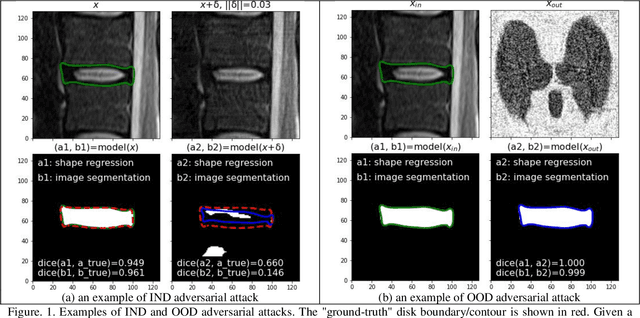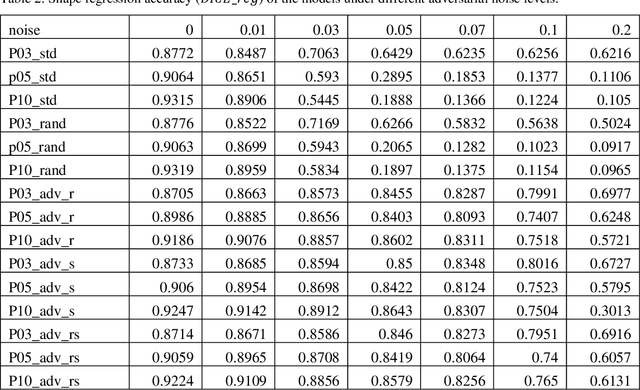Timur Urakov
Attention-based Shape-Deformation Networks for Artifact-Free Geometry Reconstruction of Lumbar Spine from MR Images
Mar 30, 2024Abstract:Lumbar disc degeneration, a progressive structural wear and tear of lumbar intervertebral disc, is regarded as an essential role on low back pain, a significant global health concern. Automated lumbar spine geometry reconstruction from MR images will enable fast measurement of medical parameters to evaluate the lumbar status, in order to determine a suitable treatment. Existing image segmentation-based techniques often generate erroneous segments or unstructured point clouds, unsuitable for medical parameter measurement. In this work, we present TransDeformer: a novel attention-based deep learning approach that reconstructs the contours of the lumbar spine with high spatial accuracy and mesh correspondence across patients, and we also present a variant of TransDeformer for error estimation. Specially, we devise new attention modules with a new attention formula, which integrates image features and tokenized contour features to predict the displacements of the points on a shape template without the need for image segmentation. The deformed template reveals the lumbar spine geometry in the input image. We develop a multi-stage training strategy to enhance model robustness with respect to template initialization. Experiment results show that our TransDeformer generates artifact-free geometry outputs, and its variant predicts the error of a reconstructed geometry. Our code is available at https://github.com/linchenq/TransDeformer-Mesh.
SymTC: A Symbiotic Transformer-CNN Net for Instance Segmentation of Lumbar Spine MRI
Jan 25, 2024



Abstract:Intervertebral disc disease, a prevalent ailment, frequently leads to intermittent or persistent low back pain, and diagnosing and assessing of this disease rely on accurate measurement of vertebral bone and intervertebral disc geometries from lumbar MR images. Deep neural network (DNN) models may assist clinicians with more efficient image segmentation of individual instances (disks and vertebrae) of the lumbar spine in an automated way, which is termed as instance image segmentation. In this work, we proposed SymTC, an innovative lumbar spine MR image segmentation model that combines the strengths of Transformer and Convolutional Neural Network (CNN). Specifically, we designed a parallel dual-path architecture to merge CNN layers and Transformer layers, and we integrated a novel position embedding into the self-attention module of Transformer, enhancing the utilization of positional information for more accurate segmentation. To further improves model performance, we introduced a new data augmentation technique to create synthetic yet realistic MR image dataset, named SSMSpine, which is made publicly available. We evaluated our SymTC and the other 15 existing image segmentation models on our private in-house dataset and the public SSMSpine dataset, using two metrics, Dice Similarity Coefficient and 95% Hausdorff Distance. The results show that our SymTC has the best performance for segmenting vertebral bones and intervertebral discs in lumbar spine MR images. The SymTC code and SSMSpine dataset are available at https://github.com/jiasongchen/SymTC.
Adversarial Robustness Study of Convolutional Neural Network for Lumbar Disk Shape Reconstruction from MR images
Feb 04, 2021



Abstract:Machine learning technologies using deep neural networks (DNNs), especially convolutional neural networks (CNNs), have made automated, accurate, and fast medical image analysis a reality for many applications, and some DNN-based medical image analysis systems have even been FDA-cleared. Despite the progress, challenges remain to build DNNs as reliable as human expert doctors. It is known that DNN classifiers may not be robust to noises: by adding a small amount of noise to an input image, a DNN classifier may make a wrong classification of the noisy image (i.e., in-distribution adversarial sample), whereas it makes the right classification of the clean image. Another issue is caused by out-of-distribution samples that are not similar to any sample in the training set. Given such a sample as input, the output of a DNN will become meaningless. In this study, we investigated the in-distribution (IND) and out-of-distribution (OOD) adversarial robustness of a representative CNN for lumbar disk shape reconstruction from spine MR images. To study the relationship between dataset size and robustness to IND adversarial attacks, we used a data augmentation method to create training sets with different levels of shape variations. We utilized the PGD-based algorithm for IND adversarial attacks and extended it for OOD adversarial attacks to generate OOD adversarial samples for model testing. The results show that IND adversarial training can improve the CNN robustness to IND adversarial attacks, and larger training datasets may lead to higher IND robustness. However, it is still a challenge to defend against OOD adversarial attacks.
CQ-VAE: Coordinate Quantized VAE for Uncertainty Estimation with Application to Disk Shape Analysis from Lumbar Spine MRI Images
Oct 20, 2020



Abstract:Ambiguity is inevitable in medical images, which often results in different image interpretations (e.g. object boundaries or segmentation maps) from different human experts. Thus, a model that learns the ambiguity and outputs a probability distribution of the target, would be valuable for medical applications to assess the uncertainty of diagnosis. In this paper, we propose a powerful generative model to learn a representation of ambiguity and to generate probabilistic outputs. Our model, named Coordinate Quantization Variational Autoencoder (CQ-VAE) employs a discrete latent space with an internal discrete probability distribution by quantizing the coordinates of a continuous latent space. As a result, the output distribution from CQ-VAE is discrete. During training, Gumbel-Softmax sampling is used to enable backpropagation through the discrete latent space. A matching algorithm is used to establish the correspondence between model-generated samples and "ground-truth" samples, which makes a trade-off between the ability to generate new samples and the ability to represent training samples. Besides these probabilistic components to generate possible outputs, our model has a deterministic path to output the best estimation. We demonstrated our method on a lumbar disk image dataset, and the results show that our CQ-VAE can learn lumbar disk shape variation and uncertainty.
 Add to Chrome
Add to Chrome Add to Firefox
Add to Firefox Add to Edge
Add to Edge